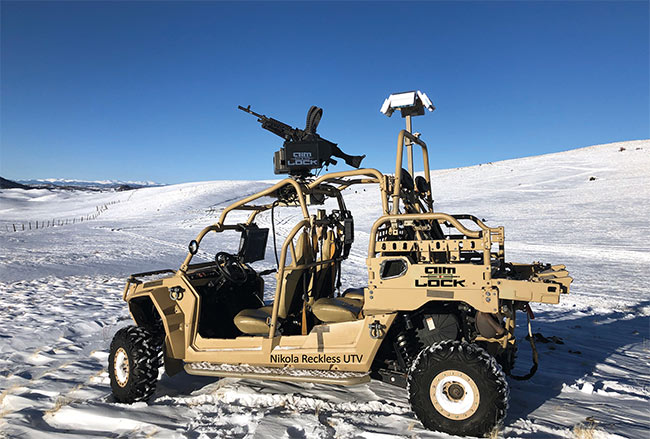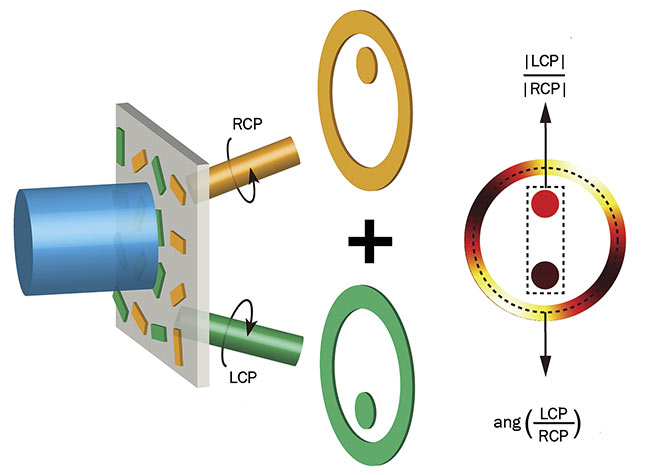As metamaterials move out of the lab, their unusual characteristics could enable enhanced performance in applications from optical switching to polarization measurement.
HANK HOGAN, CONTRIBUTING EDITOR
Metamaterials — engineered to have unique photonic and other properties — can enable previously difficult or impossible-to-achieve performance. Radar or lidar steering, for instance, can be achieved inexpensively without moving parts. Glasses for augmented or virtual reality can direct light into the eye for viewing synthetic images. Optical signals can be switched faster, and important optical parameters such as polarization can be measured more simply and could benefit from these materials.
To continue turning such possibilities into commercial realities, vendors and researchers must overcome difficulties associated with understanding, designing, and making these materials. In a sign of progress, industry is now shipping metamaterial products, while academic researchers are pushing the field’s boundaries.

The Nikola Reckless UTV (utility task vehicle) from AimLock is a prototype drone vehicle that uses metamaterial-based radar for detection, tracking, and targeting. Courtesy of Echodyne and AimLock.
According to a report from Western Market Research1, the worldwide metamaterials market stood at $396 million in 2017, with a compound annual growth rate of 22.3% through 2025. Projections indicate that the metamaterials market value could climb fivefold over eight years.
One company that is part of this growth is Echodyne Corp. of Kirkland, Wash., which makes compact solid-state beam-steering radar for a range of applications. To date, these have been in aviation, but the company is putting its metamaterial-based technology to new use.
“We’ve announced availability of our third offering, EchoDrive, which is a high-resolution cognitive imaging radar designed to increase the capability, autonomy, and safety of self-driving cars and trucks,” said Tom Driscoll, the company’s founder and chief technology officer.
The company’s products achieve their performance with metamaterials, a class of engineered substances made of microscopic structures called unit cells. These cells, similar to the hexagonal wax cells that make up a honeycomb, are repeated across the material. The features within each unit cell are designed and crafted in shape, size, and composition so that they lead to unique effects not seen in nature. A metamaterial can, for instance, exhibit a refractive index that is less than one or even negative, a property not possible with any known natural material. Applying the concept to an interface creates a metasurface, which can be considered a two-dimensional metamaterial. Metasurfaces are often optically thin, and thus are much thinner than the wavelength of light.
Metamaterials have enabled Echodyne to steer radar beams using an array of antennas. Phased-array beam steering, or altering the phase of individual antennas relative to one another to direct a beam as desired, could before only be accomplished with expensive technology, which is one reason it was found only in defense or noncommercial settings. Echodyne’s metamaterial-based technology cuts the cost and allows this high-performance beam steering to be more widely deployed, according to the company.
An optical version of the technique could be used to steer laser pulses and would lead to more compact and robust lidar. This development would be useful in self-driving cars, transportation-related applications, and optical 3D sensing at a distance.
Doing what nature cannot, however, imposes requirements. One is the size of the unit cell: It must be well below the wavelength of interest, which is a requirement for all metamaterials and metasurfaces. A parallel example of this principle is illustrated by the wire mesh in the doors of microwave ovens. The spacing in the mesh is so small that when the mesh surface is exposed to microwaves it behaves like a solid sheet of reflective metal. In the visible spectrum, though, the mesh is largely transparent. Thus, the mesh acts like a different material at different wavelengths.
So, for a given band of wavelengths, a metamaterial will have unusual properties, but for other wavelengths it will not. What’s more, the application wavelength determines the size of the metamaterial unit cell, as well as other features and, therefore, the ease of manufacture.
“The wavelengths for radar are between a few centimeters to a few millimeters, and so the geometric feature sizes required are well within the reach of a wide array of manufacturing techniques,” Driscoll said. “We realize our microwave metamaterials using printed circuit board processes.”
A possibly key advantage in surmounting manufacturing challenges is that a metasurface requires that only the very upper layer of the surface be composed of the repeated, subwavelength features. In contrast, a 3D metamaterial must consist of unit cells throughout its entire bulk. Consequently, a metasurface may be easier to fabricate.

An early prototype of a metamaterial antenna array that enables inexpensive electronic steering of radar without moving parts by allowing the phase of the different antennas to be adjusted as needed. An optical analog of this approach could steer laser pulses and thus a lidar beam. Courtesy of Echodyne.
Additionally, surface-only fabrication can make use of the planar photolithography technology developed for the semiconductor industry. And, because metasurfaces are flat, they could replace many conventional optics and thereby substantially reduce the size and weight of photonic systems.
Metamaterial applications must also contend with the difficulties associated with designing, modeling, and controlling the response of the subwavelength structures, according to Driscoll. The performance impacts of time and temperature and other environmental variables must be considered. Temperature changes, for example, can lead to slight shifts in size or spacing of structures, which, in turn, may change the properties of the metamaterial enough to have an effect.

A thin layer of hafnium dioxide (HfO2) can, as part of metamaterial, go from high reflectance to almost
complete absorptance (inset graph) with the application of a voltage (left). This could be used for fast optical modulation or switching (optical fiber concept) (right). Au: gold; AZO: aluminum-doped zinc oxide;
ITO: indium tin oxide; R: reflectance. Courtesy of Howard Lee/Baylor University.
The first wave of commercialization of metamaterials has focused on better antennas for radar and communications. Longer term, Driscoll said, there will be opportunities in improved optical devices for telecom and industry, as well as in better instrumentation and energy collection systems.
Because of metamaterials’ potential for optical and shorter wavelengths, they receive a widespread focus for academic research, with possible applications in several areas. Mark Brongersma, a materials science and engineering professor at Stanford University, gave a well-attended talk at the SPIE Optics + Photonics conference in San Diego in August 2019 about one such use.
“We’re very interested in addressing some of the challenges of augmented reality combiners,” he said.
A combiner could take the form of wearable glasses that overlay what people see in the real world with digital information and synthetic images. This capability could be used for both augmented and virtual reality applications. Brongersma said this type of overlay requires a display that offers a large field of view, high efficiency, and high transparency.
One standard way to create this capability is with a curved mirror, which, when made conventionally, is too bulky to be used in glasses. Brongersma described efforts to replace the curved mirror with flat optics, and he reported good preliminary results in achieving the necessary performance with a grating metasurface — in effect, a flat metamaterial.
Howard Lee, an assistant physics professor at Baylor University in Waco, Texas, also reported on metaconcept results at the 2019 Optics + Photonics conference. Lee works with materials that can be tuned from being transparent to being almost perfect absorbers. Known as epsilon-near-zero (ENZ) metamaterials,
the substances can undergo extreme changes in refractive index and other optical properties as a result of an applied electric voltage. According to Lee, such shifts could be useful in ultrafast optical modulation as well as dynamic holographic imaging.
“The field-effect tunability of refractive index of the ENZ material could potentially be very fast, greater than 100 GHz, and power-efficient,” he said.

An incoming light beam (blue, left)
passes through a metasurface and generates
overlapping right circularly polarized (RCP) and left
circularly polarized (LCP) beams that enable determination of the incoming beam’s polarization
by extracting the amplitude contrast (upper right) and the phase difference (lower right) between
the RCP and LCP components. Ang: angle. Courtesy of Xueqian Zhang/Tianjin University.
In his talk, Lee reported on a single-layer structure, but more recent research has revealed that multilayer structures will also work. Fabricating the layers, which are only nanometers thick, is challenging, but Lee said his group and its collaborators are working on solving the problem. According to him, optical loss in ENZ materials is a key limitation that also must be addressed.
A final example of metamaterial research results that could have widespread applications comes from a multi-institutional September 2019 Optica paper2 on direct polarization measurements. The traditional way to measure polarization commonly involves moving parts, which makes it difficult to create inexpensive or small instruments that can determine this critical parameter of light.
“Our method could lead to compact systems,” said the paper’s lead author, Xueqian Zhang, an assistant professor at the Center for Terahertz Waves at Tianjin University in Tianjin, China. “It detects the polarization of light in a single step [and] thus does not require moving parts, such as high-precision waveplates used in traditional methods.”
A key to accomplishing this measurement advancement is the ability of metasurfaces to generate — from a single incoming beam of light — two overlapping holographic images. In the work described in the paper, one of the holograms was left circularly polarized (LCP) while the other was right circularly polarized (RCP). By analyzing the interference of the two images using a newly developed technique, the researchers determined the left- and right-circular polarization components of the incident beam. From this information, they then directly identified the polarization of the original incoming light.
Changes in the polarization of light after it interacts with a material provide information about its physical properties. Various polarizations are also used to transmit multiple signals through optical fiber, thereby providing a way to encode more information. Zhang said polarization can also be used to encode data and that it plays a role in 3D displays. Thus, the ability to measure polarization or separate out polarization components in a compact device could be useful in many areas.
Currently, the researchers’ device is designed for and works well at a center wavelength of 800 nm. Zhang said new fabrication methods that have been demonstrated could in the future enable the polarization detection method to work in the UV, a consequence of the smaller unit cell size possible with the new fabrication processes.
Like others engaged in metamaterial-related research and development, the group is continuing its efforts, with one goal being further demonstration of what is possible. “We want to see that such a method can be generalized into real devices with comparable performance with current commercial polarimetry,” Zhang said. “The ultimate goal is to explore the unprecedented properties of metasurfaces and put them to use in real applications.”
References
1. Western Market Research (2019). Metamaterials market, by type (electromagnetic, terahertz, tunable, photonic, non-linear, frequency selective surface, and metamaterial absorber), by application and geography (North America, Europe, Asia Pacific and rest of the world). Analysis, share, trends, size, & forecast from 2014-2025.
2. X. Zhang et al. (2019). Direct polarization
measurement using a multiplexed
Pancharatnam-Berry metahologram. Optica, Vol. 6, Issue 9, pp. 1190-1198, www.doi.org/10.1364/optica.6.001190.